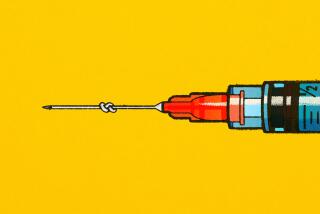A current affair
- Share via
ONLY in the beauty world would something akin to electroshock therapy have a wait list. And a $300 price tag.
But microcurrent facials have acquired near-mythical status among the Hollywood and fashion crowds and are now making their way into the mainstream. One of the more fabled practitioners, Joanna Vargas, decamps from Manhattan once each month, setting up shop in a discreet bungalow on the grounds of the Chateau Marmont. Another aesthetician with a following -- Kyoko Getz at Kate Somerville on Melrose -- has a five-month waiting list for weekend appointments. Microcurrent facials -- yes, yet another treatment billed as a “nonsurgical face-lift” -- are fast becoming the dish du jour on spa menus all over the city.
What’s all the fuss about? On a recent day at the Chateau, Vargas got to work, waving two wands charged with a low current of electricity over a lucky customer’s face. She applied delicate pressure to the contours of the forehead, cheek bones and chin. The treatment may, at times, cause a little tingling sensation.
In less skilled hands, it may, at times, cause your face to jerk uncontrollably.
Endure this, and the claims are impressive: The treatment is said to tone brows, cheeks and chins, supposedly doing for muscles on the face what a Nautilus machine does for the rest of the body -- but without any exertion.
“It takes all the tired out of my face,” says Ilaria Urbinati, 28, a stylist for “The L Word” and celebrities such as Bijou Phillips and Rob Zombie.
While other treatments leave her skin looking red or irritated, Urbinati says, the microcurrent facial allows her to make an appointment hours before an event and leave looking better than she did when she arrived.
Taking a cue from medicine
But beyond anecdotal praise, what’s behind this newest beauty trend?
Ever since Dr. Charles E. Michel tapped into an electrical current in 1875 to remove an ingrown eyelash, electricity has become a staple in the medical and cosmetic industries. Microcurrent technology (also referred to as microcurrent electrical neuromuscular stimulation) has been used for decades by doctors helping patients heal from soft tissue injuries, by orthopedics hoping to promote bone healing and by chiropractors and acupuncturists for neck and back pain. Although these treatments -- for medical use -- have been approved by the Food and Drug Administration, machines manufactured for cosmetic use are classified differently and not required to prove efficacy, only safety.
Even though the science behind the use of microcurrents for facials is lagging behind their popularity, a case can be made that they may have a beneficial effect.
According to Brian Kinney, a plastic surgeon in Century City, electricity can stimulate the lymphatic system, the growth of capillaries and the production of collagen and elastin in the skin.
It was a lesson that a Northern California chiropractor and inventor, Thomas Wing, learned in the 1980s when he began experimenting with electric current to rejuvenate facial muscles. Although Wing saw promising results, he was stymied by the FDA and eventually sold his invention to a British manufacturer. Some 20 years later, it’s come back home.
A recommended microcurrent regimen for results that last longer than a couple of days often entails six or seven consecutive weekly visits and then once a month thereafter. “Like any kind of workout,” says Getz, the aesthetician at Kate Somerville, “you have to keep doing it, and the more you do it, the stronger your muscles get.”
Makeup artist Ron Ann Myers gets her microcurrent facials at the Kevin Josephson Salon in Beverly Hills, where the aesthetician uses the wands in conjunction with a glove that also carries the electrical current. Meyers says that the effects of a single treatment last about 48 hours. “It’s great when you need a quick fix, before an awards ceremony or a special event like a wedding,” she says.
Treatments cost $100 to $300, and different salons use different devices. Wands are most popular, but gloves and electrode patches can also deliver the current. According to facialists and manufacturers of the devices, results depend mostly upon the technician and the machine. Microcurrent machines for cosmetic use are designed for comfort and relaxation; machines used by physical therapists or chiropractors deliver more of a jolt. It’s important to make sure that the machine an aesthetician uses is intended for cosmetic use and that he or she has been trained to use it. (Ask when you book your appointment.)
Vargas spent months in Europe researching which machine to buy. “There are machines that literally make your facial muscles contract and jerk, and that’s not comfortable and it’s a bit humiliating,” she says. “Then there are those where you can taste metal in your mouth, or others that leave you with red welts on your skin.”
No wonder Kinney is guarded when claims are made for the treatment. “We need to move from late-night infomercial science to real-life double blind clinical studies,” he says.
Joseph Greco, a UCLA dermatologist who specializes in cosmetics and lasers, agrees. Just because microcurrent electricity has an effect on wound healing, soft tissue damage and pain management doesn’t mean you can extrapolate the same results for facial rejuvenation. “We need to have clinical studies that show it does, in fact, work,” he says.
Patty Leoni, however, can’t wait. Leoni, 49, works as a personal assistant for Larry King and his wife Shawn and has been getting a microcurrent facial once a month for the last two years from Getz. She will tell you that the treatments are not only relaxing, but that they also actually lift the muscles on her face.
“There’s definitely a noticeable difference,” she says. “It tightens my jaw line and opens up my eyes.”
Leoni may just be sensing the increased blood flow that the treatments cause. “What people are probably seeing is localized tissue edema, which makes your skin feel tighter and causes slight swelling,” Greco explains. “There’s also this component having just done something nice for yourself. You feel good, relaxed, so a placebo effect may add to the expectation as well.”
Physicians like Greco say microcurrent treatments (and the swelling) are safe, but they doubt whether stimulating muscles is the best way to go about facial rejuvenation. “When we talk about facial aging, sagging muscles aren’t the problem,” Greco says. “The problem of wrinkles and aging skin comes from sun damage, changes in elasticity and loss of fat volume, which results in folds in skin.”
Such concerns don’t bother the faithful. Zapping away the years is, at least, a beautiful fantasy.






